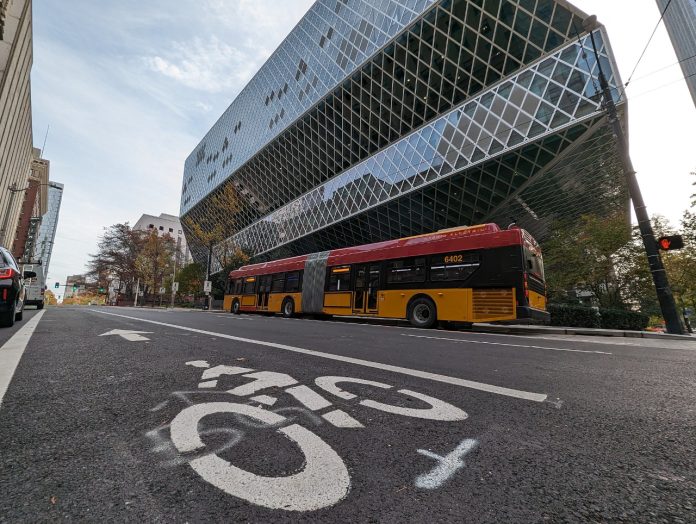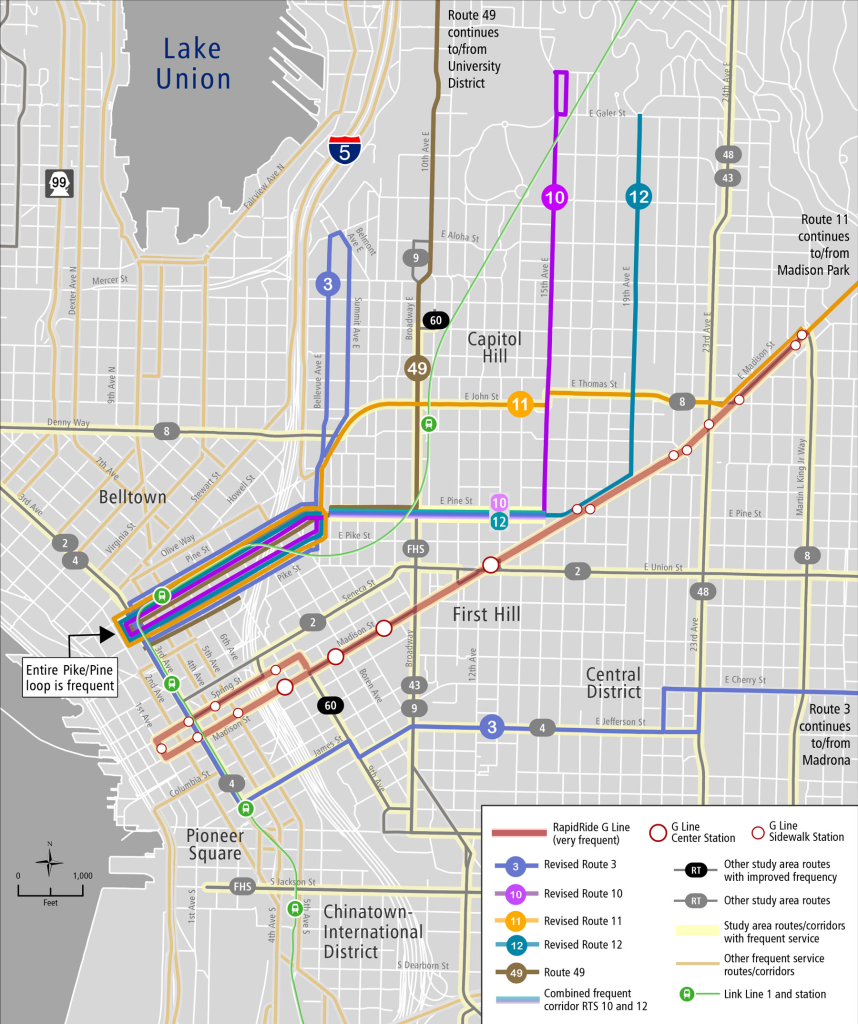
King County Executive Dow Constantine has finalized a proposal for a full slate of planned changes to bus routes around Central Seattle set to coincide with the launch of the new RapidRide G Line later this year. The proposal, which heads to the King County Council for final approval, has been refined over the past year in response to feedback from transit riders as King County Metro tries to optimize service around the new line, which will run between Downtown Seattle and Madison Valley.
As part of the $133 million upgrade, buses are planned to operate along the new G Line every six minutes for most of the day, dropping to every 15 minutes after 7pm and on Sundays. A number of routes will be modified to cover network gaps and reduce redundant overlapping, and other routes will simply see changes in their planned frequencies in response to Metro’s need to shift service hours around to create increased frequency on Madison Street. The current plan is for RapidRide G service to start this August and for all of these changes to take effect at the same time.
“The proposed service revisions to Metro’s routes around the G Line are the result of a year-long collaborative process grounded in equity, community engagement, and best practices in service design,” Constantine stated in his letter transmitting the legislation to the council. “To focus investment where needs are greatest, Metro’s engagement strategies and community partnerships focused on reaching equity priority populations — defined in Metro’s Service Guidelines as communities of color, low- or no-income populations, disabled populations, foreign-born populations, and people with limited English proficiency.”
Several routes would see decreased frequencies compared to current service levels, particularly during peak hours, a setback for one of the region’s most densely populated neighborhoods. And Constantine’s transmittal letter to the County Council includes a big caveat: “Due to current workforce and vehicle maintenance constraints, Metro may need to implement a reduced version of the proposed network and grow service over time contingent upon operational capacity.” In other words, due to its labor shortage, Metro may not be able to deliver the entire set of planned changes on the RapidRide G’s launch date, something that will become more fully clear in the months ahead.

Route 47 becomes the Route 3
The most high-profile change included in the package is a restoration of bus service to West Capitol Hill along Summit Avenue E and Bellevue Avenue E, an area that has been without direct bus service since early 2020. Numbered the Route 47 when service was indefinitely suspended, the long-standing trolley route would return as a new tail of the Route 3 between Madrona and Downtown Seattle. The Route 3 would no longer extend to Queen Anne, but the change doesn’t represent a loss of actual bus service to that neighborhood — trips would simply be run as Route 4 trips so riders can understand which route is which.
Route 3 service will only extend up into Capitol Hill every thirty minutes, and stop after 7:30pm on weekdays, 7pm on weekends. But, when it’s running, the new route will likely prove more useful than the former 47, which terminated at 3rd and Pine. Capitol Hill will have a new one-seat connection between First Hill and the Central District, and provide a better connection to Pioneer Square.

Transit advocates, including the Transit Riders Union, had advocated for the return of service to Summit Slope, and a survey Metro completed last year found a roughly even split between bringing back the 47 and increasing frequencies on other nearby routes.
Here’s a full breakdown of other proposed changes that will impact routes near the RapidRide G:
Route 10
Service on the Route 10 to Volunteer Park would be rerouted off E Olive Way to E Pine Street, the pathway the route took prior to launch of light rail service at Capitol Hill Station. The change will provide more service to an area of the neighborhood that’s been lacking bus service, but will ultimately shift the route from providing a direct connection to light rail to falling short of providing a direct connection to the RapidRide G. Riders wanting to transfer between the 10 and the G will have to walk two blocks from 15th and Pine to 17th and Madison, the nearest set of G Line stops.

Weekday service: Today’s 10- to 20-minute service will be reduced to 20-minute frequencies for most of the day, with service at night dropping from what’s currently 10-30 minutes to 30-60 minutes, a big setback for transit service along the 15th Avenue E business district and its nearby residents.
Weekend service: 15- to 30-minute service during the day will become 20-30 minutes, with 30-60 minute service remaining at night on both Saturday and Sunday.
Route 11
With the RapidRide G not extending all the way to Madison Park, the Route 11 will be moved off E Madison Street west of 24th Avenue E, increasing service along E Thomas Street between there and 15th Avenue E and taking over the routing of the current Route 10 along E John Street and E Olive Way.

Weekday service: Similar to the reductions on the Route 10, current 15- to 20-minute service will be reduced to 20 minutes for most of the day, with service at night dropping from what’s currently 15-30 minutes to 20-60 minutes.
Weekend service: Saturday and Sunday service would be mostly unchanged, with buses coming slightly more frequently during the day, every 20-30 minutes.
Route 12
The Route 12 to Interlaken Park, which shares the most overlap with the future pathway of the RapidRide G, will be rerouted onto E Pine Street through Capitol Hill instead, covering an area currently served by the Route 11. With the new Route 10, overlapping service up and down Pine Street will combine to offer fairly frequent service on the corridor. And unlike the Route 10, the new 12 will provide a direct connection to the RapidRide G.

Weekday service: 10-15 minute service throughout most of the day would drop to 20-minute service. At night, buses could come as infrequently as once per hour compared to the current 20-40 minute service.
Weekend service: Saturday and Sunday service would be mostly unchanged, with buses coming slightly more frequently during the day, every 20-30 minutes.
Route 49
Routing on the 49 between Downtown Seattle and U District station won’t change, but the workhorse route will see a fairly significant drop in service levels.
Weekday service: 15-minute service during peak hours and throughout midday would drop to 20-minute service. At night, headways will drop from 15-30 minutes to 20-30 minutes.
Saturday and Sunday service: 15-minute service throughout the day on weekends would become 20-minute service. 30-minute service at night would remain steady.
Route 60
The 60 between Westwood Village and Capitol Hill, serving South Park, Georgetown, Beacon Hill and First Hill, may be the second biggest beneficiary of these changes behind the new RapidRide G. The route will see consistent increases throughout the week at high demand times.
Weekday service: 10- to 15-minute service during peak hours would become 12-minute service, with 12-minute service midday remaining constant. At night, inconsistent service bottoming out at half-hour headways would become 20-minute service.
Saturday and Sunday service: 20-30 minute service through the day would increase to 15-minute service. At night, 30-minute service would remain steady.
In the coming months, more details are set to be revealed about the launch of RapidRide G, including the exact date when service will start. Ultimately, while some riders will see a reduction in the frequency of their bus, on net, the network of connections around Central Seattle will remain incredibly strong with the addition of a brand new high-capacity transit corridor on Madison Street.
Ryan Packer has been writing for The Urbanist since 2015, and currently reports full-time as Contributing Editor. Their beats are transportation, land use, public space, traffic safety, and obscure community meetings. Packer has also reported for other regional outlets including Capitol Hill Seattle, BikePortland, Seattle Met, and PubliCola. They live in the Capitol Hill neighborhood of Seattle.


